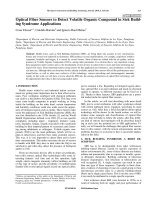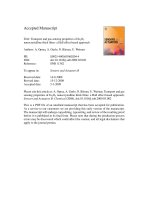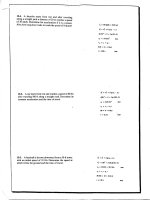Optical fiber communication solution manual
Bạn đang xem bản rút gọn của tài liệu. Xem và tải ngay bản đầy đủ của tài liệu tại đây (475.65 KB, 116 trang )
1
Problem Solutions for Chapter 2
2-1.
E =
100cos 2
π
10
8
t
+
30
°
(
)
e
x
+
20cos 2
π
10
8
t
−
50
°
(
)
e
y
+
40cos
2
π
10
8
t
+
210
°
( )
e
z
2-2. The general form is:
y = (amplitude) cos(ωt - kz) = A cos [2π(νt - z/λ)]. Therefore
(a) amplitude = 8 µm
(b) wavelength: 1/λ = 0.8 µm
-1
so that λ = 1.25 µm
(c) ω = 2πν = 2π(2) = 4π
(d) At t = 0 and z = 4 µm we have
y = 8 cos [2π(-0.8 µm
-1
)(4 µm)]
= 8 cos [2π(-3.2)] = 2.472
2-3. For E in electron volts and λ in µm we have E =
1
.240
λ
(a) At 0.82 µm, E = 1.240/0.82 = 1.512 eV
At 1.32 µm, E = 1.240/1.32 = 0.939 eV
At 1.55 µm, E = 1.240/1.55 = 0.800 eV
(b) At 0.82 µm, k = 2π/λ = 7.662 µm
-1
At 1.32 µm, k = 2π/λ = 4.760 µm
-1
At 1.55 µm, k = 2π/λ = 4.054 µm
-1
2-4. x
1
= a
1
cos (ωt - δ
1
) and x
2
= a
2
cos (ωt - δ
2
)
Adding x
1
and x
2
yields
x
1
+ x
2
= a
1
[cos ωt cos δ
1
+ sin ωt sin δ
1
]
+ a
2
[cos ωt cos δ
2
+ sin ωt sin δ
2
]
= [a
1
cos δ
1
+ a
2
cos δ
2
] cos ωt + [a
1
sin δ
1
+ a
2
sin δ
2
] sin ωt
Since the a's and the δ's are constants, we can set
a
1
cos δ
1
+ a
2
cos δ
2
= A cos φ (1)
2
a
1
sin δ
1
+ a
2
sin δ
2
= A sin φ (2)
provided that constant values of A and φ exist which satisfy these equations. To
verify this, first square both sides and add:
A
2
(sin
2
φ + cos
2
φ) =
a
1
2
sin
2
δ
1
+
cos
2
δ
1
(
)
+
a
2
2
sin
2
δ
2
+
cos
2
δ
2
(
)
+ 2a
1
a
2
(sin δ
1
sin δ
2
+ cos δ
1
cos δ
2
)
or
A
2
=
a
1
2
+
a
2
2
+ 2a
1
a
2
cos (δ
1
- δ
2
)
Dividing (2) by (1) gives
tan φ =
a
1
sin
δ
1
+
a
2
sin
δ
2
a
1
cosδ
1
+ a
2
cosδ
2
Thus we can write
x = x
1
+ x
2
= A cos φ cos ωt + A sin φ sin ωt = A cos(ωt - φ)
2-5. First expand Eq. (2-3) as
E
y
E
0 y
= cos (ωt - kz) cos δ - sin (ωt - kz) sin δ (2.5-1)
Subtract from this the expression
E
x
E
0 x
cos δ = cos (ωt - kz) cos δ
to yield
E
y
E
0 y
-
E
x
E
0x
cos δ = - sin (ωt - kz) sin δ (2.5-2)
Using the relation cos
2
α + sin
2
α = 1, we use Eq. (2-2) to write
3
sin
2
(ωt - kz) = [1 - cos
2
(ωt - kz)] =
1
−
E
x
E
0x
2
(2.5-3)
Squaring both sides of Eq. (2.5-2) and substituting it into Eq. (2.5-3) yields
E
y
E
0 y
−
E
x
E
0x
cos
δ
2
=
1
−
E
x
E
0x
2
sin
2
δ
Expanding the left-hand side and rearranging terms yields
E
x
E
0x
2
+
E
y
E
0y
2
- 2
E
x
E
0x
E
y
E
0y
cos δ = sin
2
δ
2-6. Plot of Eq. (2-7).
2-7. Linearly polarized wave.
2-8.
33
°
33
°
90
°
Glass
Air: n = 1.0
(a) Apply Snell's law
n
1
cos θ
1
= n
2
cos θ
2
where n
1
= 1, θ
1
= 33°, and θ
2
= 90° - 33° = 57°
∴ n
2
=
cos
33
°
cos
57
°
= 1.540
(b) The critical angle is found from
n
glass
sin φ
glass
= n
air
sin φ
air
4
with φ
air
= 90° and n
air
= 1.0
∴ φ
critical
= arcsin
1
n
glass
= arcsin
1
1
.540
= 40.5°
2-9
Air
Water
12 cm
r
θ
Find θ
c
from Snell's law n
1
sin θ
1
= n
2
sin θ
c
= 1
When n
2
= 1.33, then θ
c
= 48.75°
Find r from tan θ
c
=
r
12
cm
, which yields r = 13.7 cm.
2-10.
45
°
Using Snell's law n
glass
sin θ
c
= n
alcohol
sin 90°
where θ
c
= 45° we have
n
glass
=
1
.
45
sin
45
°
= 2.05
2-11. (a) Use either NA =
n
1
2
−
n
2
2
(
)
1
/
2
= 0.242
or
5
NA ≈ n
1
2
∆
= n
1
2(n
1
−
n
2
)
n
1
= 0.243
(b) θ
0,max
= arcsin (NA/n) = arcsin
0
.
242
1.0
= 14°
2-13. NA =
n
1
2
−
n
2
2
(
)
1
/
2
=
n
1
2
−
n
1
2
(1
− ∆
)
2
[
]
1
/
2
= n
1
2
∆ − ∆
2
(
)
1
/
2
Since ∆ << 1, ∆
2
<< ∆; ∴ NA ≈ n
1
2
∆
2-14. (a) Solve Eq. (2-34a) for jH
φ
:
jH
φ
= j
εω
β
E
r
-
1
β
r
∂
H
z
∂φ
Substituting into Eq. (2-33b) we have
j β E
r
+
∂
E
z
∂
r
= ωµ
j
εω
β
E
r
−
1
β
r
∂
H
z
∂φ
Solve for E
r
and let q
2
= ω
2
εµ - β
2
to obtain Eq. (2-35a).
(b) Solve Eq. (2-34b) for jH
r
:
jH
r
= -j
εω
β
E
φ
-
1
β
∂
H
z
∂r
Substituting into Eq. (2-33a) we have
j β E
φ
+
1
r
∂
E
z
∂φ
= -ωµ
−j
εω
β
E
φ
−
1
β
∂
H
z
∂
r
Solve for E
φ
and let q
2
= ω
2
εµ - β
2
to obtain Eq. (2-35b).
(c) Solve Eq. (2-34a) for jE
r
:
6
jE
r
=
1
εω
1
r
∂
H
z
∂φ
+
jr
β
H
φ
Substituting into Eq. (2-33b) we have
β
εω
1
r
∂
H
z
∂φ
+
jr
β
H
φ
+
∂
E
z
∂
r
= jωµ H
φ
Solve for H
φ
and let q
2
= ω
2
εµ - β
2
to obtain Eq. (2-35d).
(d) Solve Eq. (2-34b) for jE
φ
jE
φ
= -
1
εω
j
β
H
r
+
∂
H
z
∂
r
Substituting into Eq. (2-33a) we have
1
r
∂
E
z
∂φ
-
β
εω
j
β
H
r
+
∂
H
z
∂
r
= -jωµ H
r
Solve for H
r
to obtain Eq. (2-35c).
(e) Substitute Eqs. (2-35c) and (2-35d) into Eq. (2-34c)
-
j
q
2
1
r
∂
∂
r
β
∂
H
z
∂φ
+ εω
r
∂
E
z
∂
r
−
∂
∂φ
β
∂
H
z
∂
r
−
εω
r
∂
E
z
∂φ
= jεωE
z
Upon differentiating and multiplying by jq
2
/εω we obtain Eq. (2-36).
(f) Substitute Eqs. (2-35a) and (2-35b) into Eq. (2-33c)
-
j
q
2
1
r
∂
∂
r
β
∂
E
z
∂φ
− µω
r
∂
H
z
∂
r
−
∂
∂φ
β
∂
E
z
∂
r
+
µω
r
∂
H
z
∂φ
= -jµωH
z
Upon differentiating and multiplying by jq
2
/εω we obtain Eq. (2-37).
2-15. For ν = 0, from Eqs. (2-42) and (2-43) we have
7
E
z
= AJ
0
(ur)
e
j(
ω
t
−
β
z)
and H
z
= BJ
0
(ur)
e
j(
ω
t
−
β
z)
We want to find the coefficients A and B. From Eqs. (2-47) and (2-51),
respectively, we have
C =
J
ν
(
ua
)
K
ν
(wa)
A and D =
J
ν
(
ua
)
K
ν
(wa)
B
Substitute these into Eq. (2-50) to find B in terms of A:
A
j
βν
a
1
u
2
+
1
w
2
= Bωµ
J'
ν
(ua)
uJ
ν
(ua)
+
K'
ν
(wa)
wK
ν
(wa)
For ν = 0, the right-hand side must be zero. Also for ν = 0, either Eq. (2-55a) or (2-56a)
holds. Suppose Eq. (2-56a) holds, so that the term in square brackets on the right-hand
side in the above equation is not zero. Then we must have that B = 0, which from Eq. (2-
43) means that H
z
= 0. Thus Eq. (2-56) corresponds to TM
0m
modes.
For the other case, substitute Eqs. (2-47) and (2-51) into Eq. (2-52):
0 =
1
u
2
B
j
βν
a
J
ν
(ua)
+
A
ωε
1
uJ'
ν
(ua)
+
1
w
2
B
j
βν
a
J
ν
(ua)
+
A
ωε
2
w
K'
ν
(wa)J
ν
(ua)
K
ν
(wa)
With
k
1
2
= ω
2
µε
1
and
k
2
2
= ω
2
µε
2
rewrite this as
Bν =
ja
βωµ
1
1
u
2
+
1
w
2
k
1
2
J
ν
+ k
2
2
K
ν
[
]
A
8
where J
ν
and K
ν
are defined in Eq. (2-54). If for ν = 0 the term in square brackets on the
right-hand side is non-zero, that is, if Eq. (2-56a) does not hold, then we must have that A
= 0, which from Eq. (2-42) means that E
z
= 0. Thus Eq. (2-55) corresponds to TE
0m
modes.
2-16. From Eq. (2-23) we have
∆ =
n
1
2
−
n
2
2
2n
1
2
=
1
2
1
−
n
2
2
n
1
2
∆ << 1 implies n
1
≈ n
2
Thus using Eq. (2-46), which states that n
2
k = k
2
≤ β ≤ k
1
= n
1
k, we have
n
2
2
k
2
=
k
2
2
≈
n
1
2
k
2
=
k
1
2
≈
β
2
2-17.
2-18. (a) From Eqs. (2-59) and (2-61) we have
M
≈
2
π
2
a
2
λ
2
n
1
2
−
n
2
2
( )
=
2
π
2
a
2
λ
2
NA
( )
2
a
=
M
2
π
1
/
2
λ
NA
=
1000
2
1
/
2
0.85
µ
m
0.2
π
=
30.25
µ
m
Therefore, D = 2a =60.5 µm
(b)
M
=
2
π
2
30.25
µ
m
(
)
2
1.32
µ
m
( )
2
0.2
( )
2
=
414
(c) At 1550 nm, M = 300
2-19. From Eq. (2-58),
9
V =
2
π
(
25
µ
m
)
0.82
µm
(1.48)
2
−
(1.46)
2
[
]
1/ 2
= 46.5
Using Eq. (2-61) M ≈ V
2
/2 =1081 at 820 nm.
Similarly, M = 417 at 1320 nm and M = 303 at 1550 nm. From Eq. (2-72)
P
clad
P
total
≈
4
3
M
-1/2
=
4
×
100
%
3
1080
= 4.1%
at 820 nm. Similarly, (P
clad
/P)
total
= 6.6% at 1320 nm and 7.8% at 1550 nm.
2-20 (a) At 1320 nm we have from Eqs. (2-23) and (2-57) that V = 25 and M = 312.
(b) From Eq. (2-72) the power flow in the cladding is 7.5%.
2-21. (a) For single-mode operation, we need V ≤ 2.40.
Solving Eq. (2-58) for the core radius a
a =
V
λ
2
π
n
1
2
−
n
2
2
( )
−
1/ 2
=
2
.
40
(
1
.
32
µ
m
)
2
π
(1.480)
2
−
(1.478)
2
[ ]
1/ 2
= 6.55 µm
(b) From Eq. (2-23)
NA =
n
1
2
−
n
2
2
(
)
1
/
2
=
(1.480)
2
−
(1.478)
2
[
]
1
/
2
= 0.077
(c) From Eq. (2-23), NA = n sin θ
0,max
. When n = 1.0 then
θ
0,max
= arcsin
NA
n
= arcsin
0.077
1
.
0
= 4.4°
2-22. n
2
=
n
1
2
−
NA
2
=
(1.458)
2
−
(0.3)
2
= 1.427
a =
λ
V
2
π
NA
=
(
1
.
30
)(
75
)
2
π
(0.3)
= 52 µm
10
2-23. For small values of ∆ we can write V ≈
2
π
a
λ
n
1
2
∆
For a = 5 µm we have ∆ ≈ 0.002, so that at 0.82 µm
V ≈
2
π
(
5
µ
m
)
0.82
µ
m
1.45
2(0.002)
= 3.514
Thus the fiber is no longer single-mode. From Figs. 2-18 and 2-19 we see that the LP
01
and the LP
11
modes exist in the fiber at 0.82 µm.
2-24.
2-25. From Eq. (2-77) L
p
=
2
π
β
=
λ
n
y
−
n
x
For L
p
= 10 cm n
y
- n
x
=
1.3
×
10
−
6
m
10
−1
m
= 1.3×10
-5
For L
p
= 2 m n
y
- n
x
=
1.3
×
10
−
6
m
2
m
= 6.5×10
-7
Thus
6.5×10
-7
≤ n
y
- n
x
≤ 1.3×10
-5
2-26.
We want to plot n(r) from n
2
to n
1
. From Eq. (2-78)
n(r) = n
1
1
−
2
∆
(r/a)
α
[
]
1
/
2
= 1.48
1
−
0.02(r/25)
α
[
]
1
/
2
n
2
is found from Eq. (2-79): n
2
= n
1
(1 - ∆) = 1.465
2-27. From Eq. (2-81)
M
=
α
α +
2
a
2
k
2
n
1
2
∆ =
α
α +
2
2
π
an
1
λ
2
∆
where
∆ =
n
1
−
n
2
n
1
= 0.0135
11
At λ = 820 nm, M = 543 and at λ = 1300 nm, M = 216.
For a step index fiber we can use Eq. (2-61)
M
step
≈
V
2
2
=
1
2
2
π
a
λ
2
n
1
2
−
n
2
2
(
)
At λ = 820 nm, M
step
= 1078 and at λ = 1300 nm, M
step
= 429.
Alternatively, we can let α = ∞ in Eq. (2-81):
M
step
=
2
π
an
1
λ
2
∆ =
1086
at
820
nm
432
at
1300
nm
2-28. Using Eq. (2-23) we have
(a) NA =
n
1
2
−
n
2
2
(
)
1
/
2
=
(1.60)
2
−
(1.49)
2
[
]
1
/
2
= 0.58
(b) NA =
(1.458)
2
−
(1.405)
2
[
]
1
/
2
= 0.39
2-29. (a) From the Principle of the Conservation of Mass, the volume of a preform rod
section of length L
preform
and cross-sectional area A must equal the volume of the fiber
drawn from this section. The preform section of length L
preform
is drawn into a fiber of
length L
fiber
in a time t. If S is the preform feed speed, then L
preform
= St. Similarly, if s is the
fiber drawing speed, then L
fiber
= st. Thus, if D and d are the preform and fiber diameters,
respectively, then
Preform volume = L
preform
(D/2)
2
= St (D/2)
2
and Fiber volume = L
fiber
(d/2)
2
= st (d/2)
2
Equating these yields
St
D
2
2
= st
d
2
2
or s = S
D
d
2
(b) S = s
d
D
2
= 1.2 m/s
0.125
mm
9
mm
2
= 1.39 cm/min
12
2-30. Consider the following geometries of the preform and its corresponding fiber:
PREFORM
FIBER
4 mm
3 mm
R
25
µ
m
62.5
µ
m
We want to find the thickness of the deposited layer (3 mm - R). This can be done by
comparing the ratios of the preform core-to-cladding cross-sectional areas and the fiber
core-to-cladding cross-sectional areas:
A
preform
core
A
preform
clad
=
A
fiber
core
A
fiber
clad
or
π
(3
2
−
R
2
)
π
(4
2
−
3
2
)
=
π
(25)
2
π
(62.5)
2
−
(25)
2
[
]
from which we have
R =
9
−
7(25)
2
(62.5)
2
−
(25)
2
1/ 2
= 2.77 mm
Thus, thickness = 3 mm - 2.77 mm = 0.23 mm.
2-31. (a) The volume of a 1-km-long 50-µm diameter fiber core is
V = πr
2
L = π (2.5×10
-3
cm)
2
(10
5
cm) = 1.96 cm
3
The mass M equals the density ρ times the volume V:
M = ρV = (2.6 gm/cm
3
)(1.96 cm
3
) = 5.1 gm
13
(b) If R is the deposition rate, then the deposition time t is
t =
M
R
=
5
.
1
gm
0.5
gm /min
= 10.2 min
2-32. Solving Eq. (2-82) for χ yields
χ =
K
Y
σ
2
where Y = π for surface flaws.
Thus
χ =
(20
N /mm
3 / 2
)
2
(70
MN/ m
2
)
2
π
= 2.60×10
-4
mm = 0.26 µm
2-33. (a) To find the time to failure, we substitute Eq. (2-82) into Eq. (2-86) and
integrate (assuming that σ is independent of time):
χ
− b /2
χ
i
χ
f
∫
dχ = AY
b
σ
b
0
t
∫
dt
which yields
1
1
−
b
2
χ
f
1− b /2
− χ
i
1− b/ 2
[
]
= AY
b
σ
b
t
or
t =
2
(b − 2)A(Yσ)
b
χ
i
(2− b)/ 2
− χ
f
(2−b)/ 2
[
]
(b) Rewriting the above expression in terms of K instead of χ yields
t =
2
(b
−
2)A(Y
σ
)
b
K
i
Y
σ
2− b
−
K
f
Y
σ
2 −b
≈
2K
i
2
−
b
(b
−
2)A(Y
σ
)
b
if
K
i
b
−
2
<<
K
f
b
−
2
or
K
i
2
−
b
>>
K
f
2
−
b
2-34. Substituting Eq. (2-82) into Eq. (2-86) gives
d
χ
dt
= AK
b
= AY
b
χ
b/2
σ
b
14
Integrating this from χ
i
to χ
p
where
χ
i
=
K
Y
σ
i
2
and χ
p
=
K
Y
σ
p
2
are the initial crack depth and the crack depth after proof testing, respectively, yields
χ
−
b /2
χ
i
χ
p
∫
d
χ
= AY
b
σ
b
0
t
p
∫
dt
or
1
1
−
b
2
χ
p
1−b / 2
− χ
i
1−b / 2
[
]
= AY
b
σ
p
b
t
p
for a constant stress σ
p
. Substituting for χ
i
and χ
p
gives
2
b
−
2
K
Y
2
−
b
σ
i
b− 2
− σ
p
b− 2
[
]
= AY
b
σ
p
b
t
p
or
2
b
−
2
K
Y
2
−
b
1
AY
b
σ
i
b− 2
− σ
p
b− 2
[
]
= B σ
i
b−2
− σ
p
b−2
[
]
=
σ
p
b
t
p
which is Eq. (2-87).
When a static stress σ
s
is applied after proof testing, the time to failure is found from Eq.
(2-86):
χ
−b /2
χ
p
χ
s
∫
dχ = AY
b
σ
s
b
0
t
s
∫
dt
where χ
s
is the crack depth at the fiber failure point. Integrating (as above) we get Eq. (2-
89):
B σ
p
b−2
− σ
s
b−2
[
]
=
σ
s
b
t
s
Adding Eqs. (2-87) and (2-89) yields Eq. (2-90).
15
2-35. (a) Substituting N
s
as given by Eq. (2-92) and N
p
as given by Eq. (2-93) into Eq.
(2-94) yields
F = 1 - exp
−
L
L
0
σ
p
b
t
p
+ σ
s
b
t
s
( )
/ B
+ σ
s
b−2
[ ]
m
b−2
σ
0
m
−
σ
p
b
t
p
/ B
+ σ
p
b−2
( )
m
b− 2
σ
0
m
= 1 - exp
−
L
L
0
σ
0
m
σ
p
b
t
p
/B
+ σ
p
b− 2
[ ]
m
b −2
σ
p
b
t
p
+ σ
s
b
t
s
B
+ σ
s
b −2
σ
p
b
t
p
/B
+ σ
p
b
−
2
m
b− 2
−
1
= 1 - exp −
LN
p
1
+
σ
s
b
t
s
σ
p
b
t
p
+
σ
s
σ
p
b
B
σ
s
2
t
p
m
b −2
1
+
B
σ
p
2
t
p
−
1
≈ 1 - exp
−
LN
p
1
+
σ
s
b
t
s
σ
p
b
t
p
1
1
+
B
σ
p
2
t
p
m
b−2
−
1
(b) For the term given by Eq. (2-96) we have
σ
s
σ
p
b
B
σ
s
2
t
p
= (0.3)
15
0.5
(MN /m
2
)
2
s
0.3
(350
MN/ m
2
)
[ ]
2
10
s
= 6.5×10
-14
Thus this term can be neglected.
16
2-36. The failure probability is given by Eq. (2-85). For equal failure probabilities of the
two fiber samples, F
1
= F
2
, or
1 - exp −
σ
1c
σ
0
m
L
1
L
0
= 1 - exp −
σ
2c
σ
0
m
L
2
L
0
which implies that
σ
1c
σ
0
m
L
1
L
0
=
σ
2c
σ
0
m
L
2
L
0
or
σ
1c
σ
2c
=
L
2
L
1
1 /m
If L
1
= 20 m, then σ
1c
= 4.8 GN/m
2
If L
2
= 1 km, then σ
2c
= 3.9 GN/m
2
Thus
4.8
3.9
m
=
1000
20
= 50
gives
m =
log
50
log(4.8/ 3.9)
= 18.8
1
Problem Solutions for Chapter 3
3-1.
α dB/ km( )
=
10
z
log
P(0)
P(z)
=
10
z
log
e
α
p
z
(
)
=
10
α
p
log
e
=
4.343
α
p
(1/ km)
3-2. Since the attenuations are given in dB/km, first find the power levels in dBm for
100 µW and 150 µW. These are, respectively,
P(100 µW) = 10 log (100 µW/1.0 mW) = 10 log (0.10) = - 10.0 dBm
P(150 µW) = 10 log (150 µW/1.0 mW) = 10 log (0.15) = - 8.24 dBm
(a) At 8 km we have the following power levels:
P
1300
(8 km) = - 8.2 dBm – (0.6 dB/km)(8 km) = - 13.0 dBm = 50 µW
P
1550
(8 km) = - 10.0 dBm – (0.3 dB/km)(8 km) = - 12.4 dBm = 57.5 µW
(b) At 20 km we have the following power levels:
P
1300
(20 km) = - 8.2 dBm – (0.6 dB/km)(20 km) = - 20.2 dBm = 9.55 µW
P
1550
(20 km) = - 10.0 dBm – (0.3 dB/km)(20 km) = - 16.0 dBm = 25.1 µW
3-3. From Eq. (3-1c) with P
out
= 0.45 P
in
α = (10/3.5 km) log (1/0.45) = 1.0 dB/km
3-4. (a) P
in
= P
out
10
αL/10
= (0.3 µW) 10
1.5(12)/10
= 18.9 µW
(b) P
in
= P
out
10
αL/10
= (0.3 µW) 10
2.5(12)/10
= 300 µW
3-5. With λ in Eqs. (3-2b) and (3-3) given in µm, we have the following representative
points for α
uv
and α
IR
:
2
λλ (µµm) αα
uv
αα
IR
0.5 20.3
0.7 1.44
0.9 0.33
1.2 0.09
2.2×10
-6
1.5 0.04 0.0072
2.0 0.02 23.2
3.0 0.009
7.5×10
4
3-6. From Eq. (3-4a) we have
α
scat
=
8
π
3
3
λ
4
(n
2
−
1)
2
k
B
T
f
β
T
=
8
π
3
3(0.63
µ
m)
4
(1.46)
2
−
1
[ ]
2
(1.38×10
-16
dyne-cm/K)(1400 K)
×(6.8×10
-12
cm
2
/dyne)
= 0.883 km
-1
To change to dB/km, multiply by 10 log e = 4.343: α
scat
= 3.8 dB/km
From Eq. (3-4b):
α
scat
=
8
π
3
3
λ
4
n
8
p
2
k
B
T
f
β
T
= 1.16 km
-1
= 5.0 dB/km
3-8. Plot of Eq. (3-7).
3-9. Plot of Eq. (3-9).
3-10. From Fig. 2-22, we make the estimates given in this table:
ννm
P
clad
/P
αα
ννm
= αα
11
+ (αα
2 2
- αα
11
)P
clad
/P
5 + 10
3
P
clad
/P
01 0.02 3.0 + 0.02 5 + 20 = 25
11 0.05 3.0 + 0.05 5 + 50 = 55
21 0.10 3.0 + 0.10 5 + 100 = 105
02 0.16 3.0 + 0.16 5 + 160 = 165
31 0.19 3.0 + 0.19 5 + 190 = 195
12 0.31 3.0 + 0.31 5 + 310 = 315
3
3-11. (a) We want to solve Eq. (3-12) for α
gi
. With α = 2 in Eq. (2-78) and letting
∆ =
n
2
(0)
−
n
2
2
2n
2
(0)
we have
α(r) = α
1
+ (α
2
- α
1
)
n
2
(0)
−
n
2
(r)
n
2
(0)
−
n
2
2
= α
1
+ (α
2
- α
1
)
r
2
a
2
Thus
α
gi
=
α(r)
p(r)
r
dr
0
∞
∫
p(r) r dr
0
∞
∫
= α
1
+
(
α
2
− α
1
)
a
2
exp −Kr
2
( )
r
3
dr
0
∞
∫
exp
−
Kr
2
( )
r dr
0
∞
∫
To evaluate the integrals, let x = Kr
2
, so that dx = 2Krdr. Then
exp −Kr
2
( )
r
3
dr
0
∞
∫
exp
−
Kr
2
( )
r dr
0
∞
∫
=
1
2K
2
e
−
x
x
dx
0
∞
∫
1
2K
e
−x
dx
0
∞
∫
=
1
K
1!
0
!
=
1
K
Thus α
gi
= α
1
+
(
α
2
−
α
1
)
Ka
2
(b) p(a) = 0.1 P
0
= P
0
e
−
Ka
2
yields
e
Ka
2
= 10.
From this we have Ka
2
= ln 10 = 2.3. Thus
α
gi
= α
1
+
(
α
2
−
α
1
)
2
.
3
= 0.57α
1
+ 0.43α
2
3-12. With λ in units of micrometers, we have
4
n =
1
+
196.98
(13.4)
2
−
(1.24/
λ
)
2
1/ 2
To compare this with Fig. 3-12, calculate three representative points, for example,
λ = 0.2, 0.6, and 1.0 µm. Thus we have the following:
Wavelength λλ
Calculated n n from Fig. 3-12
0.2 µm
1.548 1.550
0.6 µm
1.457 1.458
1.0 µm
1.451 1.450
3-13. (a) From Fig. 3-13,
d
τ
d
λ
≈ 80 ps/(nm-km) at 850 nm. Therefore, for the LED we
have from Eq. (3-20)
σ
mat
L
=
d
τ
d
λ
σ
λ
= [80 ps/(nm-km)](45 nm) = 3.6 ns/km
For a laser diode,
σ
mat
L
= [80 ps/(nm-km)](2 nm) = 0.16 ns/km
(b) From Fig. 3-13,
d
τ
mat
d
λ
= 22 ps/(nm-km)
Therefore, D
mat
(λ) = [22 ps/(nm-km)](75 nm) = 1.65 ns/km
3-14. (a) Using Eqs. (2-48), (2-49), and (2-57), Eq. (3-21) becomes
b = 1 -
ua
V
2
= 1 -
u
2
a
2
u
2
a
2
+
w
2
a
2
=
w
2
u
2
+
w
2
=
β
2
−
k
2
n
2
2
k
2
n
1
2
− β
2
+ β
2
−
k
2
n
2
2
=
β
2
/ k
2
−
n
2
2
n
1
2
−
n
2
2
(b) Expand b as b =
(
β
/
k
+
n
2
)(
β
/
k
−
n
2
)
(n
1
+ n
2
)(n
1
− n
2
)
Since n
2
< β/k < n
1
, let β/k = n
1
(1 - δ) where 0 < δ < ∆ << 1. Thus,
5
β
/
k
+
n
2
n
1
+ n
2
=
n
1
(
1
−
δ
)
+
n
2
n
1
+ n
2
= 1 -
n
1
n
1
+
n
2
δ
Letting n
2
= n
1
(1 - ∆) then yields
β
/
k
+
n
2
n
1
+ n
2
= 1 -
δ
2
−
∆
≈ 1 since
δ
2
−
∆
<< 1
Therefore, b ≈
β
/
k
−
n
2
n
1
− n
2
or β = k[bn
1
∆ + n
2
]
From n
2
= n
1
(1 - ∆) we have
n
1
= n
2
(1 - ∆)
-1
= n
2
(1 + ∆ + ∆
2
+ ) ≈ n
2
(1 + ∆)
Therefore, β = k[b n
2
(1 + ∆)∆ + n
2
] ≈ k n
2
(b∆ + 1)
3-16. The time delay between the highest and lowest order modes can be found from the
travel time difference between the two rays shown here.
The travel time of each ray is given by
sin φ =
x
s
=
n
2
n
1
=
n
1
(
1
−
∆
)
n
1
= (1 - ∆)
The travel time of the highest order ray is thus
T
max
=
n
1
c
s
L
x
=
n
1
L
c
1
1
−
∆
For the axial ray the travel time is T
min
=
Ln
1
c
ϕ
θ
a
s
x
6
Therefore
T
min
- T
max
=
Ln
1
c
1
1
− ∆
−
1
=
Ln
1
c
∆
1
−
∆
≈
Ln
1
∆
c
3-17. Since
n
2
=
n
1
1
−
∆
(
)
, we can rewrite the equation as
σ
mod
L
=
n
1
∆
c
1
−
π
V
where the first tern is Equation (3-30). The difference is then given by the factor
1
−
π
V
=
1
−
πλ
2a
1
n
1
2
−
n
2
2
( )
1/ 2
≈
1
−
πλ
2a
1
n
1
2
∆
At 1300 nm this factor is
1
−
π
(
1
.
3
)
2 62.5
( )
1
1.48 2(0.015)
=
1
−
0.127
=
0.873
3-18. For ε = 0 and in the limit of α → ∞ we have
C
1
= 1, C
2
=
3
2
,
α
α +
1
= 1,
α
+
2
3
α
+
2
=
1
3
,
α
+
1
2
α
+
1
=
1
2
,
and
(
α
+
1)
2
(5
α +
2)(3
α +
2)
=
1
15
Thus Eq. (3-41) becomes
σ
int er mod al
=
Ln
1
∆
2 3c
1
+
3
∆ +
12
5
∆
2
1/ 2
≈
Ln
1
∆
2 3c
3-19. For ε = 0 we have that α = 2(1 -
6
5
∆). Thus C
1
and C
2
in Eq. (3-42) become
(ignoring small terms such as ∆
3
, ∆
4
, )
C
1
=
α
−
2
α
+
2
=
2 1
−
6
5
∆
−
2
2 1
−
6
5
∆
+
2
=
−
3
5
∆
1
−
3
5
∆
≈ −
3
5
∆
1
+
3
5
∆
7
C
2
=
3
α −
2
2(
α +
2)
=
3 2 1
−
6
5
∆
−
2
2 2 1
−
6
5
∆
+
2
=
1
−
9
5
∆
2 1−
3
5
∆
Evaluating the factors in Eq. (3-41) yields:
(a)
C
1
2
≈
9
25
∆
2
(b)
4
C
1
C
2
(
α
+
1
)
∆
2
α
+
1
=
4
∆ −
3
5
∆
1
−
9
5
∆
2 1
−
6
5
∆
+
1
1
−
3
5
∆
2 1
−
3
5
∆
4 1
−
6
5
∆
+
1
=
−
18
∆
1
−
11
∆ +
18
25
5 1
5
∆
2
24
25
∆
18
25
∆
2
(c)
16
∆
2
C
2
2
(
α
+
1)
2
(5
α +
2)(3
α +
2)
=
16∆
2
1−
9
5
∆
2
2(1−
6
5
∆) +1
2
4 1
−
3
5
∆
2
10(1
−
6
5
∆
)
+
2
6(1
−
6
5
∆
)
+
2
=
16∆
2
1−
9
5
∆
2
9 1−
4
5
∆
2
96(1
− ∆
)(1
−
9
10
∆
)4 1
−
3
5
∆
2
≈
9
24
∆
2
Therefore,
σ
int er mod al
=
Ln
1
∆
2
c
α
α +
1
α +
2
3
α +
2
1/ 2
9
25
∆
2
−
18
25
∆
2
+
9
24
∆
2
1/ 2
=
Ln
1
∆
2
2c
2(1
−
6
5
∆
)
2(1
−
6
5
∆
)
+
1
2(1
−
6
5
∆
)
+
2
6(1
−
6
5
∆
)
+
2
1/ 2
3
10 6
≈
n
1
∆
2
L
20 3c
8
3-20. We want to plot Eq. (3-30) as a function of
σ
λ
, where
σ
int er mod al
and
σ
int ra mod al
are given by Eqs. (3-41) and (3-45). For ε = 0 and α = 2, we have C
1
=
0 and C
2
= 1/2. Since
σ
int er mod al
does not vary with
σ
λ
, we have
σ
int er mod al
L
=
N
1
∆
2c
α
α +
2
α +
2
3
α +
2
1/ 2
4
∆
C
2
(
α +
1)
(5
α +
2)(3
α +
2)
= 0.070 ns/km
With C
1
= 0 we have from Eq. (3-45)
σ
int ra mod al
=
1
c
σ
λ
λ
−λ
2
d
2
n
1
d
λ
2
=
0
.
098
σ
λ
ns
/
km
at
850
nm
1.026
×
10
−2
σ
λ
ns/ km
at
1300
nm
3-21. Using the same parameter values as in Prob. 3-18, except with ∆ = 0.001, we have
from Eq. (3-41)
σ
int er mod al
/L = 7 ps/km, and from Eq. (3.45)
σ
int ra mod al
L
=
0
.
098
σ
λ
ns
/
km
at
850
nm
0.0103
σ
λ
ns/ km
at
1300
nm
The plot of
σ
L
=
1
L
σ
int er
2
+ σ
int ra
2
( )
1/ 2
vs
σ
λ
:
3-22. Substituting Eq. (3-34) into Eq. (3-33)
τ
g
=
L
c
d
β
dk
=
L
c
1
2β
2kn
1
2
+
2k
2
n
1
dn
1
dk
- 2
α +
2
α
m
a
2
α
α+ 2
2
α +
2
n
1
2
k
2
∆
( )
2
α+2
−1
× ∆ 2k
2
n
1
dn
1
dk
+
2kn
1
2
+
n
1
2
k
2
∆
d
∆
dk
=
L
c
kn
1
β
N
1
−
4
∆
α +
2
α +
2
α
m
a
2
1
n
1
2
k
2
∆
α
α +
2
N
1
+
n
1
k
2
∆
d
∆
dk
9
=
LN
1
c
kn
1
β
1
−
4
∆
α +
2
m
M
α
α +
2
1
+
ε
4
with N
1
= n
1
+ k
dn
1
dk
and where M is given by Eq. (2-97) and ε is defined in Eq.
(3-36b).
3-23. From Eq. (3-39), ignoring terms of order ∆
2
,
λ
d
τ
d
λ
=
L
c
dN
1
d
λ
1
+
α − ε−
2
α +
2
m
M
α
α+
2
+
LN
1
c
α − ε −
2
α +
2
d
d
λ
∆
m
M
α
α +
2
where
N
1
= n
1
- λ
dn
1
d
λ
and M =
α
α
+
2
a
2
k
2
n
1
2
∆
(a)
dN
1
d
λ
=
d
d
λ
n
1
− λ
dn
1
d
λ
= - λ
d
2
n
1
d
λ
2
Thus ignoring the term involving ∆
d
2
n
1
d
λ
2
, the first term in square brackets
becomes -
L
c
λ
2
d
2
n
1
d
λ
2
(b)
d
d
λ
∆
m
M
α
α+ 2
=
m
α
α+ 2
d
∆
d
λ
1
M
α
α +2
+ ∆
−α
α +
2
dM
d
λ
1
M
α
α +2
+
1
(c)
dM
d
λ
=
α
α
+
2
a
2
d
d
λ
k
2
n
1
2
∆
(
)
=
α
α
+
2
a
2
d
∆
d
λ
k
2
n
1
2
+
2k
2
∆
n
1
dn
1
d
λ
+
2kn
1
2
∆
dk
d
λ









